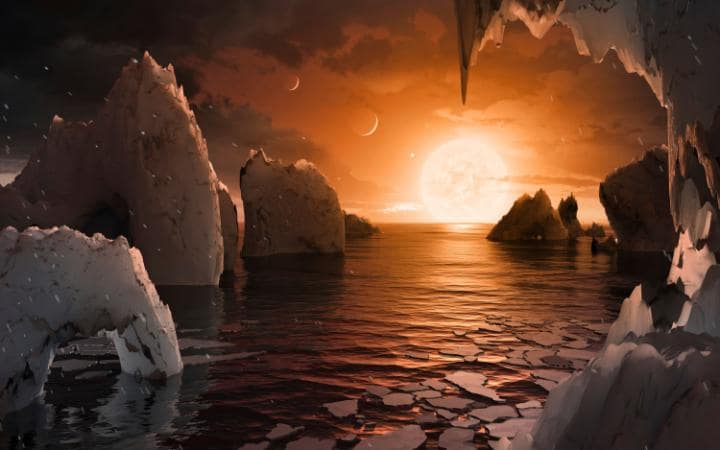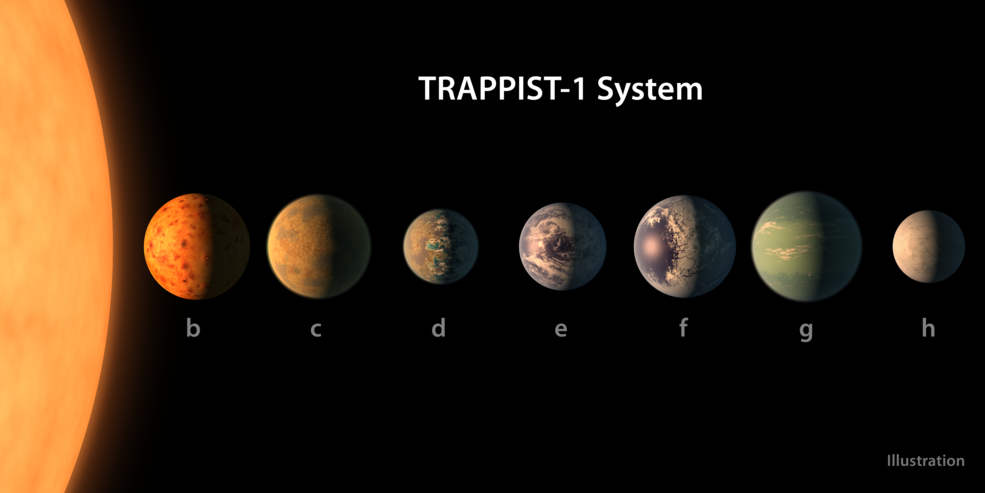The National Aeronautics and Space Administration (NASA) announced the discovery of seven Earth sized exo-planets, on 22nd of February last Wednesday, in a live press conference. And since then, the news has taken the world by storm.
The Google doodle took the initiative in spreading the word around. The simple and attractive animation not only raised awareness, it also sparked excitement and awe.

The newly discovered seven exo-planets are located about 39 light years, that is almost 235 trillion miles away, in the famous constellation Aquarius, orbiting the star TRAPPIST-1. It is named after the Transiting Planets and Planetesimals Small Telescope in Chile which was used in the initial observation activities. After meticulous observations of TRAPPIST-1 it is found that this dim, ultra-cool, dwarf star is younger than our own Sun and slightly larger than Jupiter. It shines about 200 times fainter than the Sun which means it is twilight throughout the day on a surface of those planets. The TRAPPIST’s cool nature has thus allowed favourable temperature conditions on the seven planets that orbit it.
Three of the planets of TRAPPIST-1 were discovered back in 2016 by a team of astronomers led by Michaël Gillon from the University of Liège in Belgium using ground—based telescopes. Later the NASA’s Spitzer with the support of some more has confirmed and discovered the existence of seven planets in the system. The “transit” method that searches for tiny amounts of dimming caused by a world passing in front of the star blocking its light was used in finding of the planets.
The TRAPPIST’s companions are not officially named yet. They are simply identified by the alphabetical characters “b” to “h”, “a” being the star itself. They are said to be located close to the star and closer to each other as well. If the seven planets were in the Solar system, they are said to fit inside the orbit of Mercury. In comparison, the TRAPPIST system is a compact environment, resulting clear geographical views of the neighboring planet as observed from one planet’s surface. Their TRAPPIST would be seen many times larger than how we see our Sun and their fellow planets will be seen much bigger than our moon.
The orbital time of these seven members is also reduced to amusing amounts due to their close proximity to the ultra-cool star. One year on these planets range from 1.5 to 20 Earth days. Also it is said to be possible that the same side of the planet face the star thus causing extreme weather conditions not experienced on Earth.
The interesting fact is that all of these planets are roughly around the size of our mother planet and that at least five of them may have masses similar to Earth as well. The observations made using the Hubble Space Telescope on the planets have led the scientists to believe that most planets may possess rocky and dense surfaces. Three of the planets are located in the habitable zone of the TRAPPIST system and is said to have the temperatures ranging from 0 to 100 degrees Celsius. Therefore the astronomers also speculate on existence of water in liquid form in these planets.
Further observations are to be carried out or being initiated to find out if the exo-planets have atmospheres and liquid water oceans. The effects of radiation caused by the star on the planets are yet to be found out. If favourable results are gained, it will be concluded that the planets may have the capability of supporting life as well.
No discovery of alien life has therefore been made on these planets yet, but the decade ahead will most certainly confirm whether or not we are alone in the universe. Also the probabilities of human civilizations beyond the solar system will grow hereafter.
image credits: Google, NASA/JPL-Caltech
references :
https://www.theguardian.com/science/2017/feb/22/thrilling-discovery-of-seven-earth-sized-planets-discovered-orbiting-trappist-1-star
https://www.nasa.gov/press-release/nasa-telescope-reveals-largest-batch-of-earth-size-habitable-zone-planets-around
http://www.mirror.co.uk/science/exoplanet-discovery-scientists-could-find-9901145
http://www.telegraph.co.uk/technology/2017/02/23/seven-earth-sized-exoplanets-discovered-does-nasa-announcement/
http://www.sciencealert.com/breaking-news-nasa-is-making-a-huge-exoplanet-announcement-right-now



